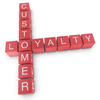Grow & Retain Your Customer Base with Online Loyalty Programs

Today, companies of every size are using online loyalty programs in greater numbers to attract customers and build loyalty.
In 2015, companies spent a shocking $2 billion on customer loyalty programs that attracted over 3 billion members. Why the strong interest? Research shows that firms spend about five times more money to acquire new customers than retaining existing ones.
While the ubiquity of loyalty programs has made them appear as a universal remedy to help companies save money, retain customers and conquer stiff competition, not every program succeeds. These programs fail when companies build loyalty programs without considering what type of reward customers want. Thus, when launching an online loyalty program, company executives need to match the right program that satisfies the member.
Growing your share of the wallet
Companies with custom online loyalty programs benefit the most. That is, they identify and satisfy the customers' unique preferences to gain a bigger share of the customer's wallet. In fact, many consumers claim that loyalty programs would be better if more options were available and they could choose their own reward.
"To deliver the right reward to the right person at the right moment, companies need to segment its client list," said Chris Teso, founder and CEO of Chirpify. He added, this can be based on demographics such as age or income level, behaviors including heavy or moderate usage and psychographics such as customer interests.
Furthermore, companies should determine whether customers seek offers that fill hedonic or utilitarian needs. Customers with hedonic goals chase rewards offering fun, pleasure and fantasy. Alternatively, utilitarian goals motivate consumers to seek economic and functional value such as coupons, discounts on favorite items, instant quantity discounts, point reward systems, money voucher towards future purchases and more. Offering the customer the right reward leaves a positive lasting impression that brings him back again and again to capture greater total spending.
Online loyalty programs offer key benefits
Effective loyalty programs offer value. They drive repeat business, increase brand awareness, build the company reputation and increase sales and profits. Yet, the key advantage of online over traditional loyalty programs is data collection, said Teso. Data mining highlights consumer consumption trends and patterns. From this information, marketers can create attractive rewards programs, making them a consumer's top choice. Furthermore, an online loyalty program offers additional benefits. These include:
Increased savings: No more plastic cards! This saves initial development, distribution and printing costs associated with tangible cards because the customer's mobile device doubles as the loyalty card.
Free organic earned media: The customer raises your company's presence and attracts customers when they use their mobile device to connect with their social communities.
Convenience: Not only do tech-savvy customers seek instant gratification, but they also control when and from where they participate in a program.
Building long-term customer relationships
"A loyalty provider should use technology that rewards consumer spending as well as consumer brand advocacy on mobile and social media," said Teso.
At the bare minimum, companies need to use the following technology: a database, a data collection tool such as online forms or an app, and a method of communication whether that be social media, email or sms. While email, website and social media networks are required channels, mobile apps are nice to have and can boost your program to the next level.
Combining demographic, location, email and social media data for re-marketing is invaluable. This provides insight on what drives customer loyalty, which customers exhibit loyalty and what business conditions increase consumer loyalty.
When searching for a provider, technology is not the only important factor. Companies should seek an innovative provider that demonstrates expertise crafting loyalty programs that connect emotionally with today's consumer, according to Teso. Use a vendor that not only engages but rewards the customer immediately. Finally, look for an honest service provider that offers a secure platform to protect the customers' data.
Michelle Wicmandy is a longtime contributor to Website Magazine, a lecturer at the University of Houston Downtown and the chief marketing officer at Collective Changes.

Subscribe to Our Newsletter!
Latest in Software








